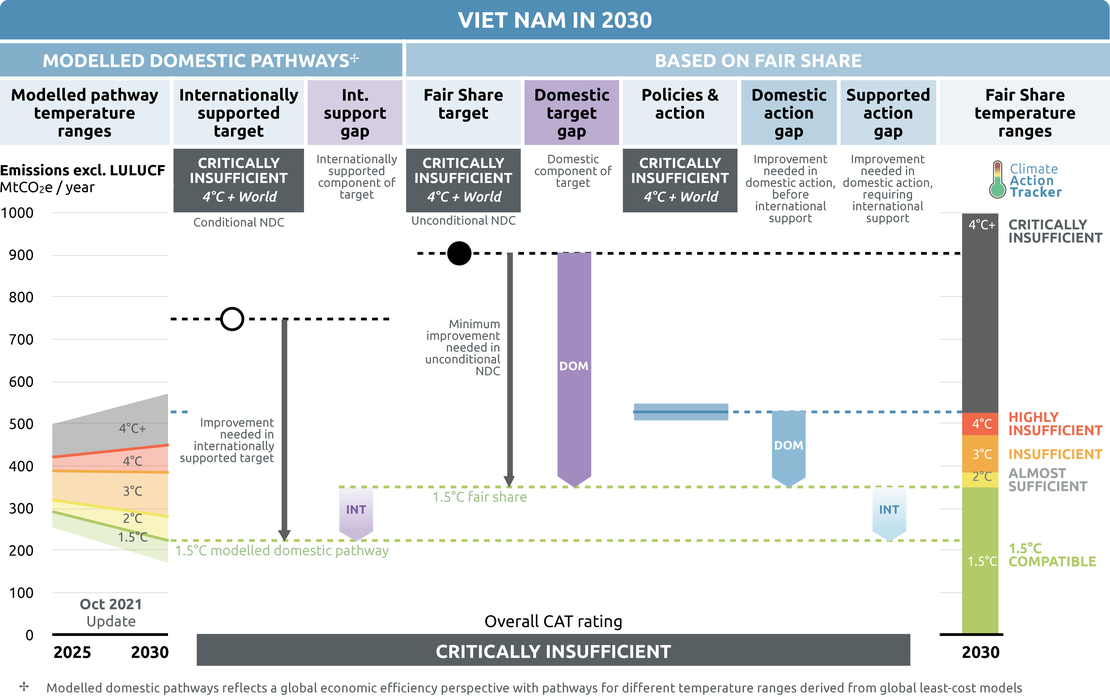Targets
Paris Agreement targets
NDC description
Viet Nam submitted its updated Nationally Determined Contribution (NDC) to the UNFCCC in September 2020 (Viet Nam Government, 2020a). While numerically stronger, it will still be easily overachieved with current policies and action and will not drive further climate action. We therefore do not consider Viet Nam's target to be stronger than the previous one.
Viet Nam has unconditionally committed to reduce GHG emissions by 9% by 2030 below business as usual levels (BAU). Viet Nam committed to a conditional target of reducing GHG emissions by 27% below BAU based on international support.
The new unconditional target translates to 903 MtCO2e/yr in absolute emissions levels for 2030 (excluding LULUCF). The first NDC of an 8% emissions reduction below BAU did not include the industry sector (nor the high cement emissions in this sector). The CAT calculated that target to be 919 MtCO2e/yr in absolute emissions levels for 2030 (excluding LULUCF) factoring in industry emissions.
The new NDC claims it represents Viet Nam’s ‘highest level of effort’, yet it is not a true progression in scaling up climate action, as it requires no additional effort compared to current policies. Viet Nam is on track to vastly overachieve its updated NDC with its current policies.
The BAU pathway the targets are based on is vastly over inflated. For the BAU the government assumes a very optimistic economic growth that does not correspond to past trends. A Paris Agreement fair share target of 350 MtCO2e by 2030 (excluding the land use and forestry sector) would ensure real progress in climate action.
The CAT rates Viet Nam’s internationally supported target and its fair share target as “Critically Insufficient”.
Viet Nam’s internationally supported target is rated as “Critically Insufficient”. This rating is based on comparing the conditional NDC target to the modelled domestic pathways. The conditional target is over three times higher (748 MtCO2e) than the 1.5C domestic pathway (223 MtCO2e) for 2030. The “Critically insufficient” rating indicates that Viet Nam’s internationally supported target in 2030 reflects minimal to no action and is not at all consistent with the Paris Agreement’s 1.5°C temperature limit. If all countries were to follow Viet Nam’s approach, warming would exceed 4°C.
Viet Nam’s fair share target is rated as “Critically Insufficient”. This rating compares the unconditional NDC target to the fair share pathway. The unconditional target (903 MtCO2e) is over 2.5 times more than a 1.5˚C Compatible faire share target (350 MtCO2e).
The “Critically insufficient” rating indicates that Viet Nam’s fair share target in 2030 reflects minimal to no action and is not at all consistent with the Paris Agreement’s 1.5°C temperature limit. Viet Nam’s target is not in line with any interpretation of a fair approach to meeting the Paris Agreement’s 1.5°C limit. If all countries were to follow Viet Nam’s approach, warming would exceed 4°C.
Further information on how the CAT rates countries (against modelled domestic pathways and fair share) can be found here.
Last NDC update
Viet Nam submitted its NDC update in September 2020, but failed to increase its ambition.
While numerically stronger, it can still be easily met with current policies and will not drive further climate action. We therefore do not consider Viet Nam's target to be stronger than the previous one.
The updated NDC has improved transparency with a sectoral breakdown of how the target will be achieved.
The implementation plan of the updated NDC is not clear as there are a number of measures listed without a timeframe. However, it offers considerably more information in relation to sectoral targets, an impact assessment, a co-benefit analysis, and indicators for monitoring and evaluation compared to the first NDC, improving on transparency and clarity, but with only a minor improvement on ambition.
While Viet Nam has made some improvements to the structure of its NDC, it did reduce its coverage of gases. The updated NDC does not include full greenhouse gas coverage, as it does not include PFCs and SF6. These were stated as included in the old NDC, but they were not mentioned in the technical report to the first NDC.

Net zero and other long-term target(s)
Viet Nam announced a net zero by 2050 target during the COP26 World Leaders' Summit. Viet Nam has not submitted its long-term strategy to the UNFCCC.
Further analysis
Latest publications
Stay informed
Subscribe to our newsletter







